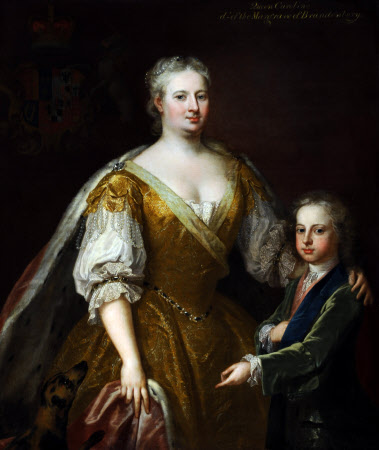Queen Caroline (of Brandenburg Ansbach) (1683–1737) and her son Prince William Augustus, Duke of Cumberland (1721–1765)
William Aikman (Cairnie 1682 - London 1731)
Category
Art / Oil paintings
Date
circa 1730
Materials
Oil on canvas
Measurements
1245 x 991 mm (49 x 39 in)
Order this imageCollection
Hardwick Hall, Derbyshire
NT 1129123
Caption
This three-quarter-length portrait by William Aikman was possibly commissioned by Queen Caroline in about 1730 and presented by her to Lady Dorothy Savile, Countess of Burlington. Caroline and her youngest son William Augustus, pictured here, had a close bond, possibly because of her early separation from her eldest son Frederick, the death of a second son as a tiny infant and the stillbirth of a third. It is probable that George I had been approached by William's parents during the 1720s with a proposal that the British-born prince should inherit the British throne, while their eldest son remain in Hanover to succeed as elector. George I's death in 1727, and the diplomatic imperative to bring Frederick to London in 1728, put paid to any such ambition. Text adapted from Florence Grant, 'Enlightened Princesses: Caroline, Augusta, Charlotte and the Shaping of the Modern World' (Ed. Joanna Marschner), 2017, cat. 23.04, p.389.
Summary
Oil painting on canvas, Queen Caroline (of Brandenburg Ansbach) (1683–1737) and her son Prince William Augustus, Duke of Cumberland (1721–1765) by William Aikman (Forfar 1682 – London 1731), inscribed: top right: Queen Caroline / d r of the Margrave of Brandenburg, circa 1730. Two three-quarter-length portraits of Queen Caroline and the Duke of Cumberland. The Queen stands three-quarter length slightly right, wearing a gold brocade dress, white sleeves and pink ermine cloak, her left arm resting on the boy's shoulder, who stands beside her, right, wearing a green coat; an Italian background, left; arms, top left.
Provenance
Possibly in the collection of Queen Caroline; possibly from whom, by gift or by perquisite to Lady Dorothy Savile, Countess of Burlington, Chiswick House (see Horace Walpole, ‘Visits to Country Houses’, Walpole Society, Vol.XVI, 1927, as at Chiswick, 1760); The Hon. George James Welbore Agar-Ellis, later 1st Baron Dover (A Catalogue of the Pictures at Hardwicke Hall) 1817; William George Spencer Cavendish, 6th Duke of Devonshire (Handbook of Chatsworth and Hardwick), 1845;and thence by desecent until, following the death of the 10th Duke of Devonshire, Hardwick Hall and its contents were accepted by HM Treasury in part payment of death duties and transferred to the National Trust, in 1959
Credit line
Hardwick Hall, The Devonshire Collection (acquired through the National Land Fund and transferred to The National Trust in 1959)
Makers and roles
William Aikman (Cairnie 1682 - London 1731), artist previously catalogued as attributed to Jacopo Amigoni (Naples c.1682 - Madrid 1752), artist previously catalogued as attributed to Enoch Seeman the younger (Gdańsk c.1694 – London 1744), artist previously catalogued as attributed to Thomas Hudson (Devonshire 1701 – Twickenham 1779), artist previously catalogued as attributed to Sir Godfrey Kneller (Lübeck 1646 - London 1723), artist previously catalogued as attributed to Charles Jervas (Dublin 1675 – London 1739), artist
Exhibition history
Enlightened princess: Caroline, Augusta, Charlotte and the Shaping of the Modern World, Kensington Palace, London, 2017, no.cat. 23.04 Enlightened princess: Caroline, Augusta, Charlotte and the Shaping of the Modern World, Yale Center for British Art, Connecticut, 2017, no.cat. 23.04
References
Enlightened Princesses: Caroline, Augusta, Charlotte and the Shaping of the Modern World (Ed. Joanna Marschner), cat. 23.04, p.389

